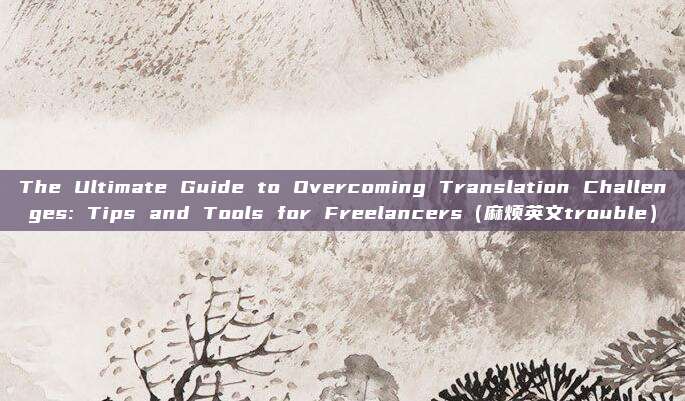The Ultimate Guide to Overcoming Translation Challenges: Tips and Tools for Freelancers(麻烦英文trouble)
温馨提示:这篇文章已超过230天没有更新,请注意相关的内容是否还可用!
Article Content:
Introduction:
In today's globalized world, language barriers can be a major obstacle for freelancers who work across borders. Whether you are a writer, translator, or any other professional dealing with diverse languages, overcoming translation challenges is crucial to your success. This article aims to provide you with practical tips and tools to tackle these obstacles effectively, ensuring that your work is accurate and culturally sensitive.
Understanding the Challenges

Before diving into solutions, it's important to recognize the common translation challenges that freelancers face:
1、Linguistic Differences: Each language has its unique grammar, vocabulary, and syntax. Misunderstandings can arise if the translator is not proficient in the source and target languages.
2、Cultural Nuances: Words, phrases, and expressions that are common in one language may not have a direct equivalent in another, leading to cultural misinterpretations.
3、Terminology Consistency: Jargon and specialized vocabulary can vary widely between languages, making it difficult to maintain consistency throughout a project.
4、Formatting and Layout: The layout and formatting of documents can differ significantly from one language to another, requiring additional time and attention.
Strategies for Success
Now that we've identified the challenges, let's explore some strategies to overcome them:
1、Build Strong Language Skills: As a freelancer, it's crucial to continuously improve your language skills. This includes reading, writing, listening, and speaking fluently in both the source and target languages. Consider enrolling in language courses or using language learning apps.
2、Cultural Competency: To bridge cultural gaps, research the culture of your target audience. Understanding their values, norms, and humor will help you translate more effectively and avoid insensitive or offensive content.
3、Specialized Dictionaries and Resources: Invest in specialized dictionaries and terminology guides related to your field. This will ensure you have the necessary resources to maintain consistency and accuracy in your translations.
4、Use Reliable Translation Tools: Translation tools, such as Google Translate or DeepL, can help you quickly identify potential issues and find appropriate terminology. However, always rely on these tools with caution, as they may not always be accurate.
5、Seek Feedback: Collaborate with colleagues or friends who are native speakers of the target language to review your translations. Their feedback can be invaluable in ensuring that your work is both accurate and culturally appropriate.
6、Learn from Mistakes: Keep a translation journal or blog to reflect on common mistakes and challenges. Analyzing these errors will help you improve over time.
Best Practices
In addition to the above strategies, consider these best practices to enhance your translation process:
1、Understand the Context: Before starting a translation, make sure you understand the context of the project. This includes knowing the purpose of the document, the intended audience, and any specific instructions provided by the client.
2、Time Management: Set clear deadlines for your translation projects and stick to them. This will help you manage your workload efficiently and meet client expectations.
3、Continuous Learning: The field of translation is constantly evolving. Stay updated with the latest industry trends, tools, and best practices. This will ensure that you remain competitive and up-to-date with client requirements.
4、Professional Development: Consider attending workshops, webinars, and conferences related to translation and interpretation. These events offer opportunities to network with professionals in your field and learn from their experiences.
Conclusion
Translation challenges can be daunting, but with the right mindset and tools, you can overcome them with ease. By continuously building your language skills, understanding cultural nuances, using reliable translation tools, and seeking feedback, you can produce accurate, culturally sensitive translations that will help you thrive as a freelance translator. Embrace the learning curve, and you'll be well on your way to becoming a valued professional in the translation industry.
网站文章、图片来源于网络,以不营利的目的分享经验知识,版权归原作者所有。如有侵权请联系删除!





还没有评论,来说两句吧...